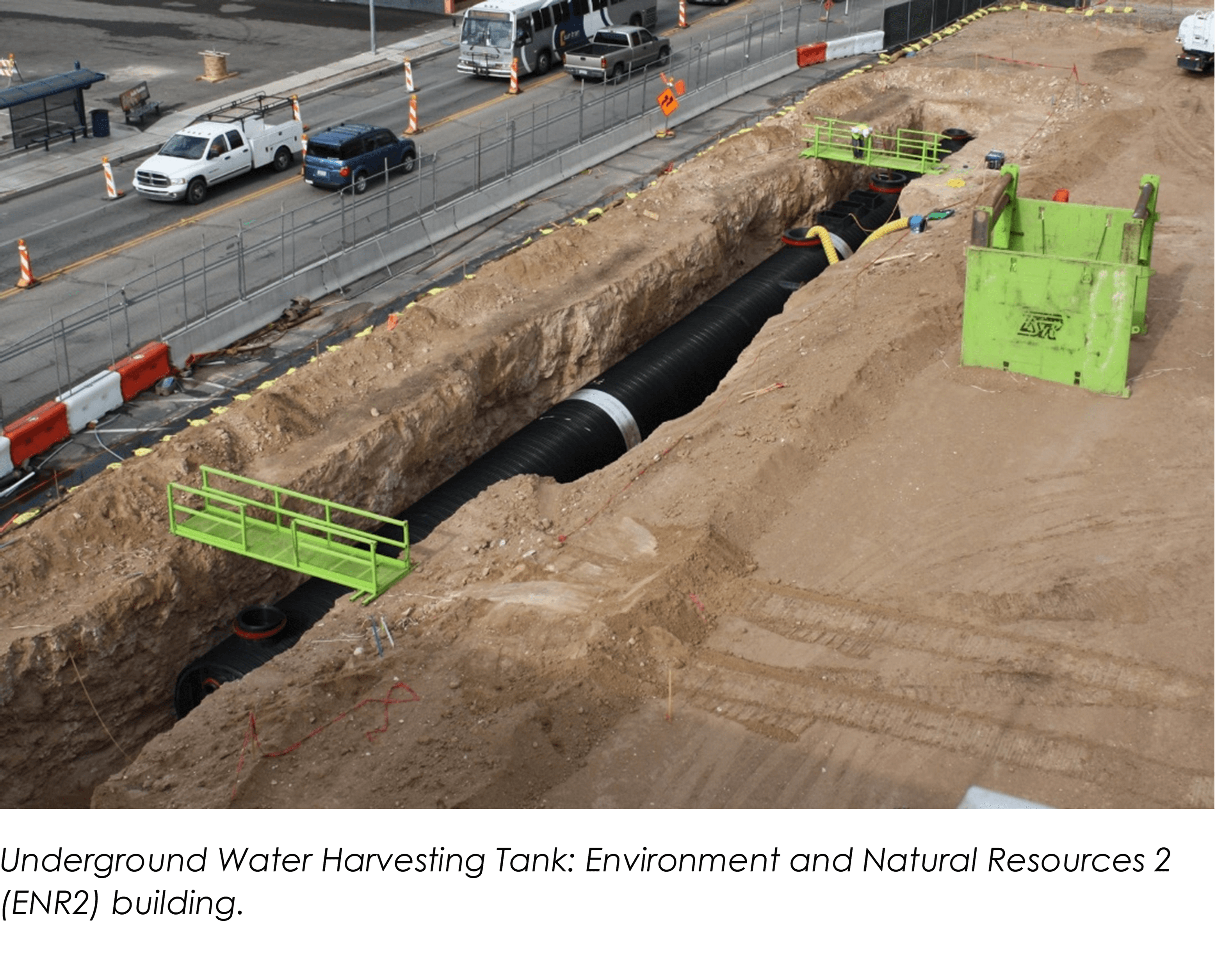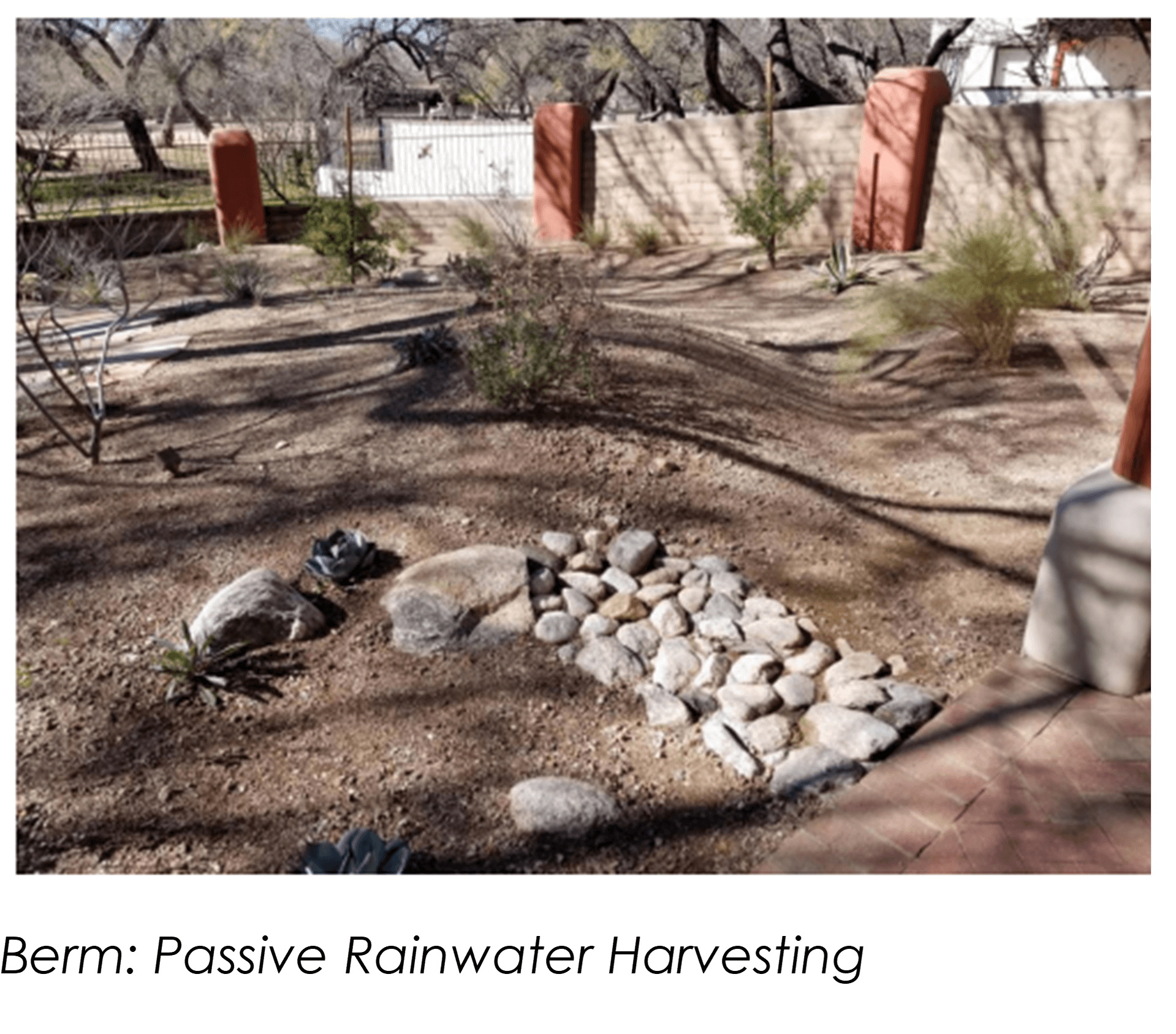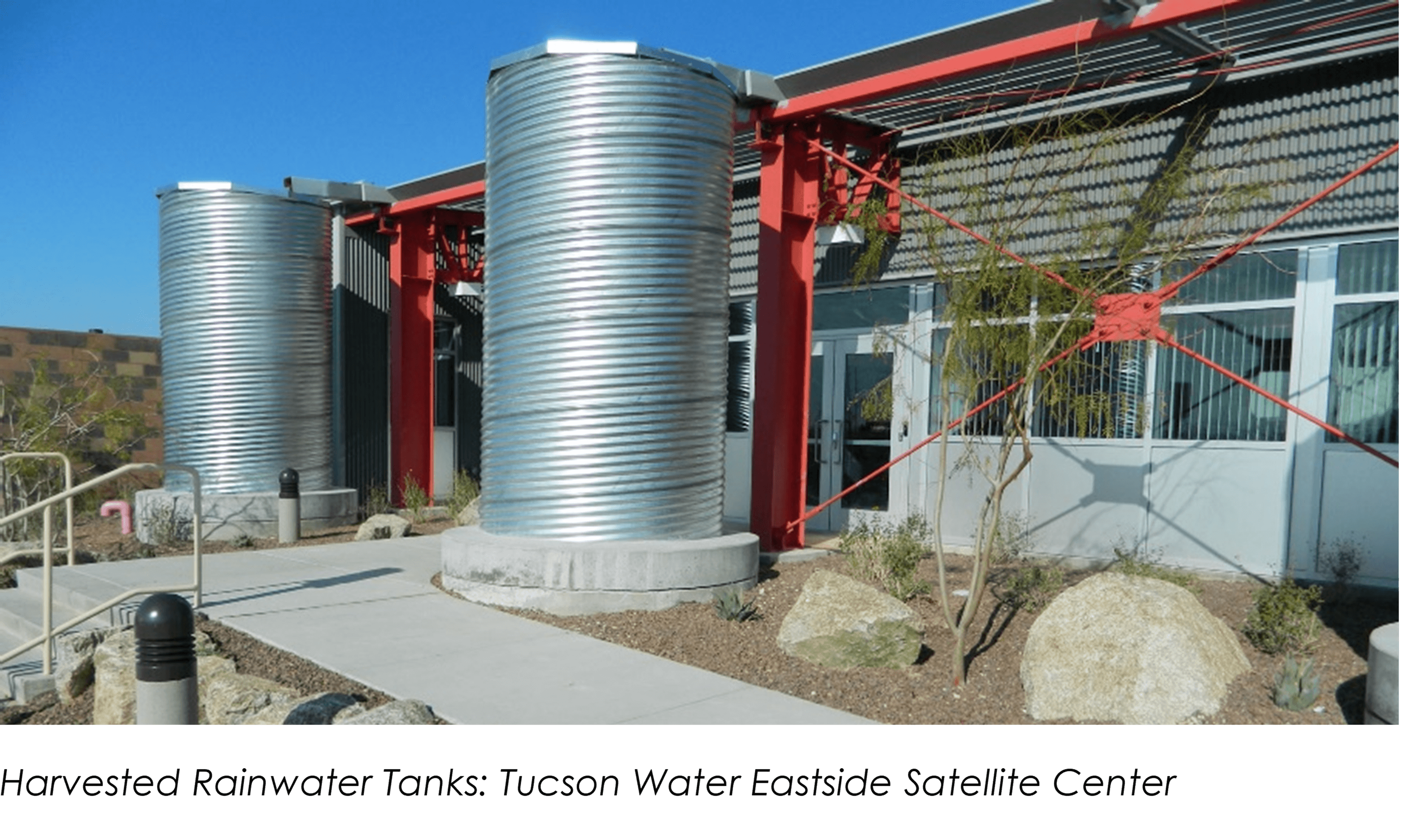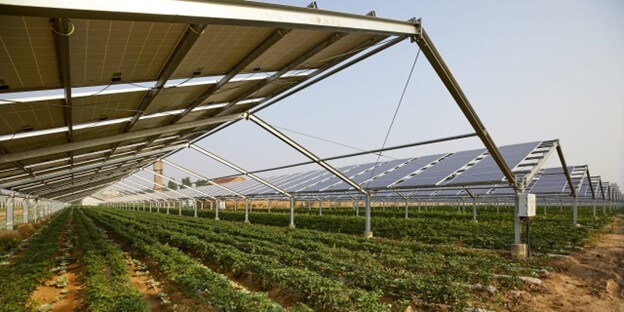Implementing Rainwater Harvesting in Tucson
By Madeline McCaskill + Joyce Kelly, RA, NCARB, CCP

Here in Tucson, water is a sacred resource. Rain often serves as relief for the dry Sonoran Desert but unfortunately Tucson only has two seasons: a monsoon in the summer and smaller scattered storms in the winter. The summer season lasts from July to September and the winter one is in December and January. The driest months are May and June, when people wish the summer monsoon would arrive faster than it does. There is a way to take advantage of the little rain given, making the dryer season bearable for plants and people.
So Much Potential
In total between rainy seasons, we get approximately 11 inches of rain per year. That means a property collects 0.6 gallons per inch of rainwater a year. That amount of water can be easily stored for later use. Rainwater harvesting systems can be implemented on any site if the local law allows it. Here in Tucson, it is not only allowed but encouraged. Considering how valuable water is here in the Sonoran Desert it makes sense to harvest free water. Tucson is home to the Watershed Management Group, Inc, a non-profit organization that develops community-based solutions for the long-term prosperity of people and the environment. This group recognized the potential of rainwater harvesting in 2002.
Rebates and Incentives
The City of Tucson provides up to a $2000 rebate for those who install rainwater harvesting systems. Rebates for passive systems are based on the size of the basins. The value is calculated at $1.50 dollars per gallon of water that can be stored in the basins. The minimum requirement is that it must hold at least one inch of rain. The rebate value for an active harvesting system is $1.00 per gallon unless it cannot hold more than one inch of rain where it would then drop to $.50 per gallon. All features on the property can be combined to achieve a higher rebate value. Six steps must be completed before the rebate money is given. These range from taking an eligible rainwater harvesting workshop in designing to installing the system within a year of attending the class. A site visit confirming all requirements were met is the last step. According to the Tucson Agenda an ordinance has been enforced to promote businesses to implement rainwater harvesting and as of January 2022 the city has “reviewed and approved 137 commercial rainwater harvesting plans. In most cases, businesses quickly comply and often end up saving much more water than the 50% required by the ordinance” (Prendergast). Since then, 525 projects have been added to the list as more businesses are required to meet these new standards. Tucson has made it easier to implement rainwater harvesting into a building’s system.
Passive Rainwater Harvesting
Passive and active rainwater harvesting systems each have their own pros regarding installation and use. Passive is the most cost-effective of the two options and is more doable for an individual. Passive rainwater harvesting is creating a system with soil, rock, and mulch that maximizes collection and infiltration. By creating small hills called berms and lower areas known as basins, gravity will naturally force the water to pool where you want it to collect. Rock dams and gravel drains can be installed to prevent the water from going where it is not needed. Mulch can also be added where the water is collected to delay evaporation. Pavers and bricks without mortar can also be used in the process because they allow water to slip in between their cracks. Concrete and asphalt should not be used because water cannot find a way around them which can lead to flooding and erosion. When installing a passive rainwater harvesting system it is best to do it where there is not much vegetation already installed because excavating the site could damage the existing plants. Irrigation using this system will be limited to rainy days because there is no storage tank to prevent the water from evaporating or draining into the ground.
To obtain a rebate from the City of Tucson for passive rainwater harvesting contractors must install a system that meets the following requirements.
- All water should be infiltrated within 24 hours.
- Berm height should be 4 inches above overflow.
- Berms must be 2 to 4 times as wide as they are tall.
- Use organic mulch for infiltration areas.
- Use rock mulch for conveyance areas if needed.
Active Rainwater Harvesting
Active rainwater harvesting is better for Tucson’s dry climate because it allows water to be collected and stored for later use. It uses a roof to collect the water via gutters into tanks. From there, water can be directed with standard drip irrigation systems. Water can be collected from any roofed structure on the property with at least 2% slope. Flat roofs are considered the best for rainwater harvesting because the 2% slope of the roof creates less of a chance for water to be lost from overflowing gutters. Roofing materials do not impede rainwater harvesting but polymer-coated roofs and galvanized steel and aluminum are considered the best. Debris is less likely to be collected by the falling rainwater and the roof is not as easily damaged. When selecting a tank consider how much water you want to store for the dry seasons, how much space you have for the tank and the cost of installation. Unlike passive rainwater harvesting which can be easily done alone, active rainwater harvesting has special contractors and requirements.
To obtain a rebate for active rainwater harvesting contractors must install a system that meets the following requirements.
- Use high-quality materials (schedule 40PVC, painted to withstand UV, sheet metal leaf catchers).
- Install a closed system (no light in tanks, screen tanks, and prevent insects).
- Install a system that minimizes maintenance (debris filters and first flush devices).
- Tanks must be installed on level pads (created from concrete or compact sand).

Real World Examples
There are many great examples of active rainwater harvesting systems located in Tucson. One of these examples is the Tucson Water Eastside Satellite Center. In 2007 ABA Architects incorporated rainwater harvesting cisterns as a design element that make it stand out. The water that is stored in these cisterns is used for the buildings landscaping. This saves water for those who receive it from Tucson Water by not wasting it on landscaping. Another example is the Environment and Natural Resources 2 (ENR2) building on the UA campus resembling a shaded slot canyon. GLHN, the Architect and Engineer of Record, incorporated a 52,000-gallon water storage tank located under the sidewalk of the building. Because of the building rainwater harvesting abilities and shaded design it can support a diverse array of plants that are different from the standard drought resistant plants local to Arizona. When rainwater falls on the building’s roof it is by a semi open air pipeline that gives water to all the levels as it travels to the underground tank that stores the remaining water for later use. Active rainwater harvesting systems provide an opportunity for landscaping that would be harder to accomplish in Arizona.
Retired architect Kim Fernández and her husband have also embraced rainwater harvesting, with both active and passive rainwater harvesting systems located on their property. Their property located in Midtown Tucson houses 2000-gallon tanks that are connected to an irrigation system that waters the orchard and the garden at the back of the property. The system is also connected to an outdoor shower that is used for most of the year. Passive rainwater harvesting includes having trees planted in wells surrounded by mulch that help store rainwater as well as the already harvested rainwater from the irrigation system. The natural vegetation at the front of the property is also very lush from a passive rainwater harvesting system. When asked about the amount of maintenance that is needed to keep everything running. Kim Fernández said, “It really does not require that much maintenance. The main thing that needs to be maintained is the pump.” It is also only during the summer that the water stored in the tanks runs out and water from the city is used. With this system implemented on her property, Kim Fernández has provided a great example of how rainwater harvesting systems can be implemented in people’s lifestyles.
How can Harvested Rainwater be Used?
Harvested rainwater is used for landscape use because without further treatment the water is not potable. According to the CDC “Water treatment options include filtration, chemical disinfection, or boiling. Filtration can remove some germs and chemicals. Treating water with chlorine or iodine kills some germs but does not remove chemicals or toxins. Boiling the water will kill germs but will not remove chemicals.” There is also UV disinfection that uses UV light to prevent microorganisms from reproducing, making them safe to consume. These methods make it more potable, but it is difficult to ever be considered as potable as drinking water without using all the methods listed. If completely potable water is desired the water would have to be tested and treated regularly which could take more time and money. Regardless of whether the water is potable or non-potable, water can still be used. Aside from landscaping it can also be used to flush toilets, saving 1.6-0.8 gallons of potable water used per flush.
Combining Rainwater Harvesting with Agrivoltaic Systems
There is not only potential for buildings to implement rainwater harvesting systems but there is also a new sophisticated passive rainwater collection system for Agrivoltaic systems. Agrivoltaic systems use the land under photovoltaic arrays for agriculture that grows better under shade. The one thing that is missing is to make this system more sustainable is a sustainable water source. Combining solar energy collection with rainwater collection makes Agrivoltaics an environmental win-win. Luckily, much like rainwater that is collected from roofs, there is a lot of water that lands on the solar panels that can be captured. Rainwater collected from the solar panels can be used to irrigate the plants that grow on the land. Harvested rainwater is used for irrigation anyway. According to the article “Rainwater Management in Agrivoltaic Systems – Research & Development Potential,” there are research opportunities for these systems. “There is a high potential for the development of agrivoltaics-adapted irrigation systems…. Linking sensor data from within the field with plant models and weather data/forecasts could be used to create a highly efficient irrigation control system” (This is something that would be extremely helpful during the dry season here in Tucson, by keeping track of the high weather temperatures for more efficient use of the harvested rainwater. With refinements to rainwater-fed irrigation systems, Agrivoltaic systems will become increasingly sustainable… These systems will have significant economic and environmental potential soon.
Summary
Rainwater harvesting provides a solution to today’s water concerns by giving people an opportunity to use the free water that lands on their property. Because it is a one-time installation with minimal maintenance required these systems are truly an efficient way to lower ones water usage. The options offered for what kind of system a person wants to install give plenty of flexibility for people to find out what works best for them. Increasingly, people will realize how rainwater harvesting opportunities can be implemented to lower their water bills and conserve water.
References:
Eccles, Alek, and About Alek Eccles Alek Eccles is a technical writer and professional content creator. Education in English and science; experience in chemical storage. “Blog.” Water Tanks, Plastic Tanks, Septic Tanks, Storage Containers, 17 Apr. 2023, www.ntotank.com/blog/how-to-capture-rainwater-on-your-roof.
“Harvesting the Rain Part 1: Passive Rainwater Harvesting.” Watershed Management Group, 14 Jan. 2021, watershedmg.org/newsmedia/harvesting-rain-part-1-passive-rainwater-harvesting.
“Harvesting the Rain Part 2: Active Rainwater Harvesting.” Watershed Management Group, 14 Jan. 2021, watershedmg.org/newsmedia/harvesting-rain-part-2-active-rainwater-harvesting.
Prendergast, Curt, and Caitlin Schmidt. “The Daily Agenda: Making up for Lost Time.” Tucson Agenda, 13 Nov. 2023, tucsonagenda.substack.com/p/the-daily-agenda-making-up-for-lost?utm_campaign=email-half-post&r=ec7m9&utm_source=substack&utm_medium=email. Accessed 14 Nov. 2023.
“Rainwater Collection.” Centers for Disease Control and Prevention, 16 Mar. 2021, www.cdc.gov/healthywater/drinking/private/rainwater-collection.html.
Rainwater Harvesting Rebate – Official Website of the City of Tucson, www.tucsonaz.gov/files/sharedassets/public/water/documents/rebate-program/rwh-rebate-changes-july-2023-2.pdf.
“Residential Customer Rebates.” City of Tucson, www.tucsonaz.gov/Departments/Water/Conservation/Residential-Customer-Rebates. Accessed 10 Oct. 2023.
Rößner, Johanna-Viktoria. “RAINWATER MANAGEMENT IN AGRIVOLTAIC SYSTEMS – RESEARCH & DEVELOPMENT POTENTIAL.” 8th World Conference on Photovoltaic Energy Conversion, Sept. 2022, pp. 996–998, doi: https://publica-rest.fraunhofer.de/server/api/core/bitstreams/a0e76b5e-e1ed-417f-9f4b-277531fd89cd/content.
US Department of Commerce, NOAA. “Tucson Monthly Climate Reports for 2023.” National Weather Service, NOAA’s National Weather Service, 30 Sept. 2023, www.weather.gov/twc/2023MonthlyClimateReports.





